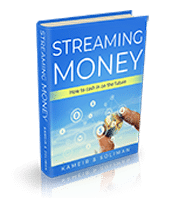Content Monetization
Publisher or other media site owner have limited options to monetize their content. This is a basic outline.
1. Revenue from CPM display advertising on site
CPM stands for ‘cost per thousand’ where M denotes ‘Mille’. The site owner such as FT.com charges advertisers a rate card price (for example $50 CPM) according to the number of its ads shown to site visitors. Ads may be served by the site owners own ad server or more commonly through a third-party ad network service such as Google AdSense as is the case with my sites.
 2. Revenue from CPC advertising on site (pay per click text ads)
2. Revenue from CPC advertising on site (pay per click text ads)
CPC stands for ‘Cost Per Click’. Advertisers are charged not simply for the number of times their ads are displayed, but according to the number of times they are clicked. These are typically text ads similar to sponsored links within a search engine but delivered over a network of third-party sites by a search engine such as Google
Typical costs per click can be surprisingly high, i.e. they are in the range $0.10 to $4, but sometimes up to $20 for some categories such as ‘life insurance’ which have a high value to the advertiser. The revenue for search engines or publishers from these sources can also be significant. For financial year 2005, Google reported its search revenues as follows: Google Sites Revenues – Google-owned sites generated revenues of $1.098 billion, or 57% of total revenues. Google Network Revenues – Google’s partner sites generated revenues, through AdSense programs totaling $799 million, or 42% of total revenues.
For me, the search content networks are one of the biggest secrets in online marketing with search engines such as Google generating over a third of their revenue from the network, but some advertisers not realizing their ads are being displayed beyond search engines and so not served for this purpose.
Google is the innovator and offers options for different formats of ad units including text ads, display ads, streamed videos and now even cost per action as part of its pay per action scheme.
3. Revenue from Sponsorship of site sections or content types
A company can pay to advertise a site channel or section. For example, bank HSBC sponsors the Money section on the Wanadoo/Orange portal (www.wanadoo.com) or www.orange.co.uk. This type of deal is often struck for a fixed amount per year. It may also be part of a reciprocal arrangement, sometimes known as a ‘contra-deal’ where neither party pays.
4. Affiliate revenue (CPA, but could be CPC)
Affiliate revenue is commission based, for example I display Amazon items on my sites and receive around 5% of the cover price as a fee from Amazon. Such an arrangement is sometimes known as Cost Per Acquisition (CPA ).
Increasingly this approach is replacing CPM or CPC approaches where the advertiser has more negotiating power. For example, in 2005 manufacturing company Unilever negotiated CPA deals with online publishers where it paid for every e-mail address captured by a campaign rather than a traditional CPM deal. However, it depends on the power of the publisher who will often receive more revenue overall for CPM deals. After all, the publisher cannot influence the quality of the ad creative or the incentivisation to click which will affect the Clickthrough rate on the ad and so the CPM.
5. Subscriber data access for e-mail marketing.
The data a site owner has about its customers is also potentially valuable since it can said different forms of e-mail to its customers if they have given their permission that they are happy to receive e-mail either from the publisher or third parties. The site owner can charge for adverts placed in its newletter or can deliver a separate message on behalf of the advertiser (sometimes known as list rental). A related approach is to conduct market research with the site customers.
6. Other models
Other models are revenue from subscription access to content and revenue from Pay Per View access to documents. Here payment occurs for single access to a document, video or music clip which can be downloaded. It may or may not be protected with a password or Digital Rights Management. Digital rights management (DRM) The use of different technologies to protect the distribution of digital services or content such as software, music, movies, or other digital data.
Considering all of these approaches to revenue generation together, the site owner should seek to use the best combination of these techniques to maximize the revenue. To assess how effective different pages or sites in their portfolio are at generating revenue, they will use two approaches. The first is eCPM, or effective Cost Per Thousand. This looks at the total they can charge (or cost to advertisers) for each page or site. Through increasing the number of ad units on each page this value will increase. The other alternative to assess page or site revenue generating effectiveness is Revenue per click (RPC), which is also known as Earnings Per Click (EPC). This is particularly important for affiliate marketers who make money through commission when their visitors click through to third party retail sites such as Amazon, and then purchase there.




